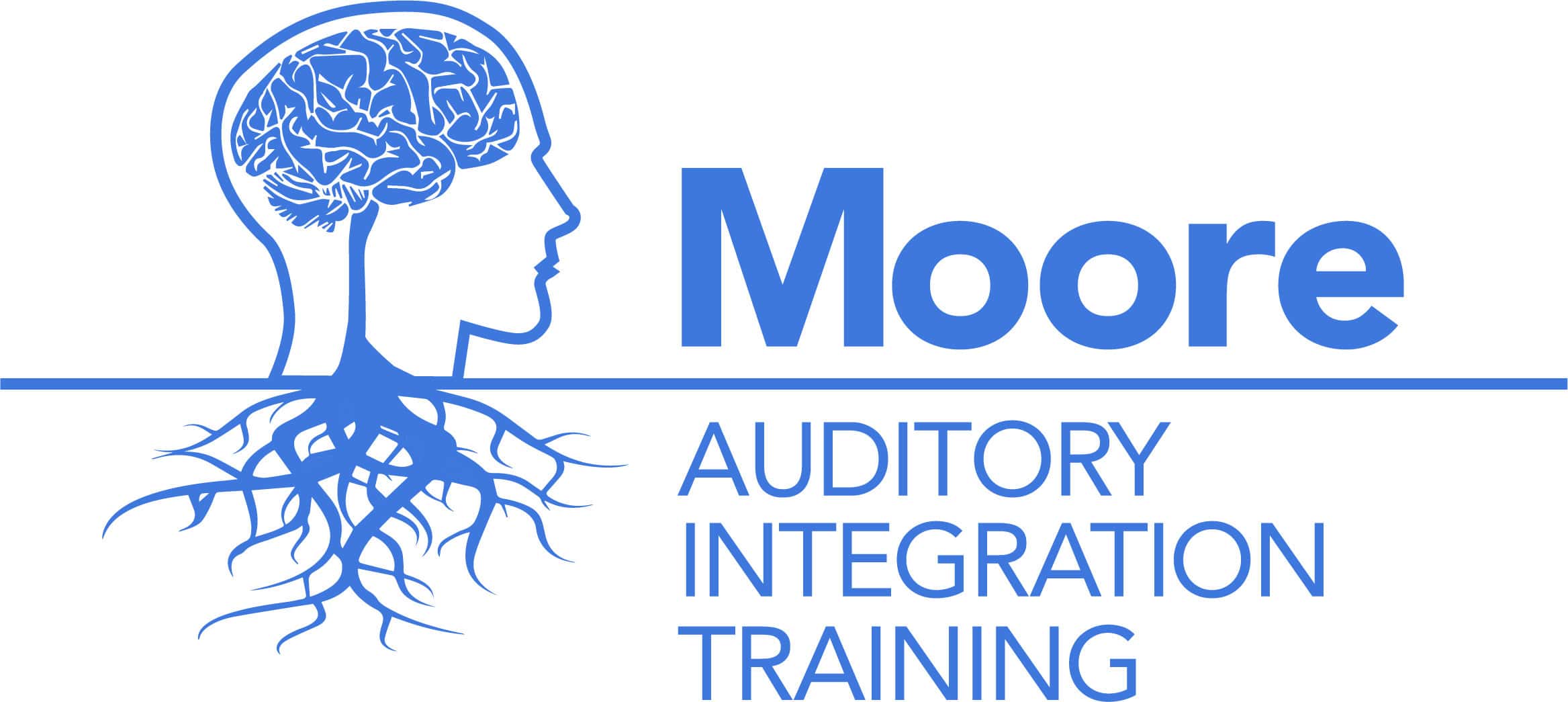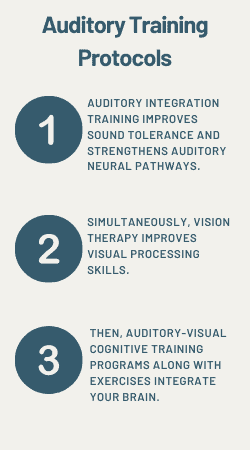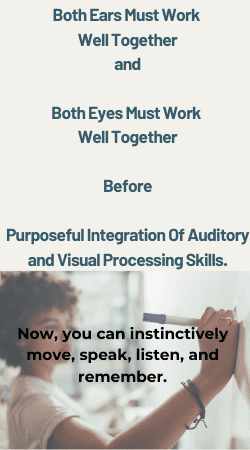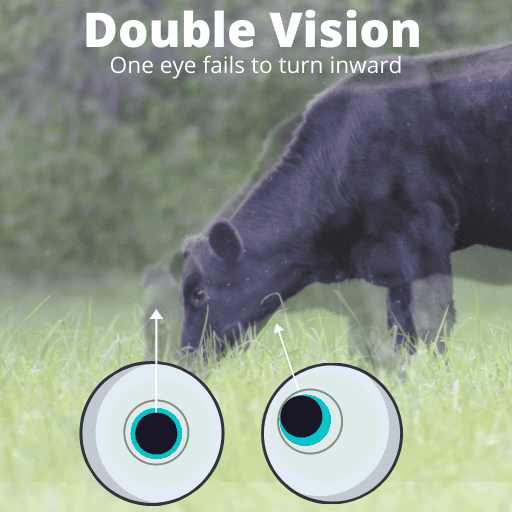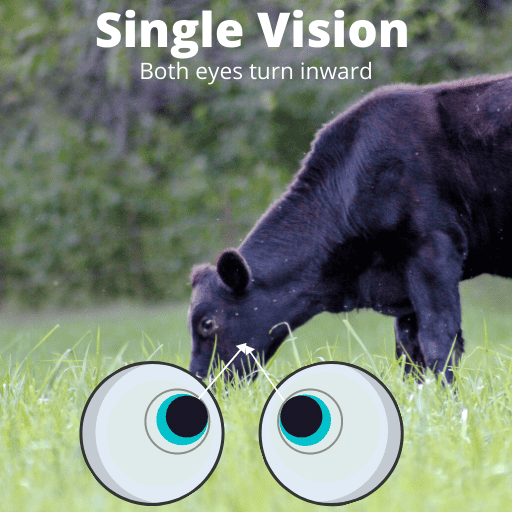Auditory-Visual Training Protocols
Improving Responses to Therapy and Your Ability to Maintain Progress
Auditory-Visual Training Protocols
An Auditory-Visual Training Protocol is a step-by-step plan for your Auditory Integration Training program.
Cheri screen for visual processing concerns using fun activities. Children and teens have no idea what Cheri is observing allowing for observation of INSTINCTIVE BEHAVIORS.
When visual processing difficulties are diagnosed by an optometrist specializing in visual processing assessments, Cheri collaborates with your developmental or neuro-rehabilitation optometrist.
Goals: emotional health, strong responses, maintain progress
Use a holistic approach that improves their ability to respond strongly to auditory training, vision therapy, and maintain progress.
Everyone needs these instinctive skills in all environments: home, work, outside, academic settings
- Listening with comprehension and remembering
- Reading with comprehension and remember
- Instinctive movements
- Fixed depth perception
- Clear and single vision looking near, far, and from one place to another
Is it difficult to instinctively move, speak, listening, and remember?
When competing background speech or noise irritates or upsets you, this is a clue there is a weakness in your auditory system.
Interesting Auditory-Visual Facts
Eye movement, middle-ear bone movement, and speech are all motor movements intricately communicating with each other. When you hear a sound, you instinctively turn your eyes toward the sound. While you look for the source of the sound, you know what you are looking for because you have already labeled the sound.
Interesting Fact
Have you ever wondered why sounds make you look? Recently, researchers found evidence that what you hear stimulates eye movement milliseconds before your eardrum moves. Your auditory, visual, and motor neural pathways constantly interact.
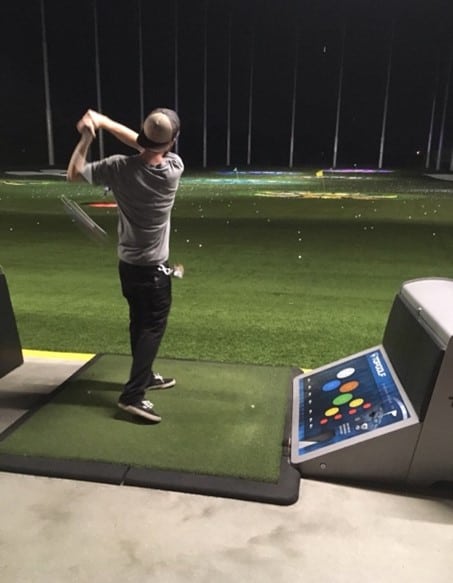
Are you a Parent?
Schedule a FREE Phone Session.
Are You A Professional?
Receive consultation support upon completion of HAvIT courses. Learn how to use the Moore Auditory Visual Questionnaire for relationship building and how to interpret automatically generated reports.
Save time and money with the automatically generated Moore Auditory Visual Questionnaire Report, a wonderful advocacy tool.
Watch animated videos to recognize auditory visual processing stress and coping behaviors.
Educational videos teach you What to Observe and How to Observe using fun activities from the booklet, Moore Auditory Visual Observation Activities.
Auditory Integration Training is based on:
- Comprehensive Hearing Test with the help of Cheri
- Comprehensive Visual Evaluation
- Your Moore Auditory-Visual Questionnaire Report
- An Ear, Nose, and Throat evaluation if never seen by an ENT doctor
- Medical history
- Trauma history, injuries
- Emotional health
- Academic challenges
Sound Intolerance Has a Domino Effect
When sounds are too loud, unsafe, the brain is suppose to instinctively turn down the loudness of the sound.
When there are strong, negative emotional responses, these are clues that your hearing system fails to turn down the volume of sounds. Schedule a FREE Phone Session.
Interesting, this is one of the reasons you find it difficult to hear after you attend a loud rock concert. Is your brain protecting you?
The Brain Cannot Use Double Vision
A sample of having to consciously find where to start reading each line.
Can you imagine having to consciously process information from each eye?
Chronic double vision and print appearing to move is not a choice.
Your anxiety is high when you must figure out which image is real and which one is fake.
Writing and boardwork is a like climbing Mt Everest every day!
When eyes fail to work together, you are unsure of how to move.
Does reading or movement make you feel naseous?
I am still astonished by what I experienced when I unexpectedly loss part of my vision.
Then, I experienced a miracle in my vision loss journey that is now helping concussion clients.
Essential for All Ages: Strong Auditory Visual Processing Skills
Your brain learns instinctive auditory and visual processing skills during the first 26 years of life through what is seen, heard, speech, and movements.
The maintenance of cognitive skills, strong auditory and visual processing skills, requires both eyes to work together with excellent 20/20 vision and both ears working together with no hearing loss.
My hearing loss with sound intolerance page shares what researchers found. Stimulation from your hearing and visual system affects all ages, the young and old.
When there is sound intolerance due to hearing loss, auditory integration training helps clients successfully wear their hearing aids.
Complete a Moore Auditory-Visual Questionnaire?
Understanding the root of one’s challenges improves emotional health and helps us request accommodations.
Cheri writes an advocacy letter reviewed by you and your Moore Auditory-Visual Questionnaire Report improving communication with your family physician for referrals and audiologist for additional hearing tests.
FDA Statement On AIT
“Auditory Integration Training remediates impairments in auditory discrimination (sound sensitivity and auditory distortion) associated with Autism, Learning Disabilities, and related disorders – ADD, ADHD, CAPD (Central Auditory Processing Deficits), SPD (Sensory Processing Disorder), Dyslexia.“
Are you ready to complete the Moore Auditory-Visual Questionnaire?
Discover what questions to ask and what to observe during visual activities.
Complete the questionnaire to receive your Auditory-Visual Report.
